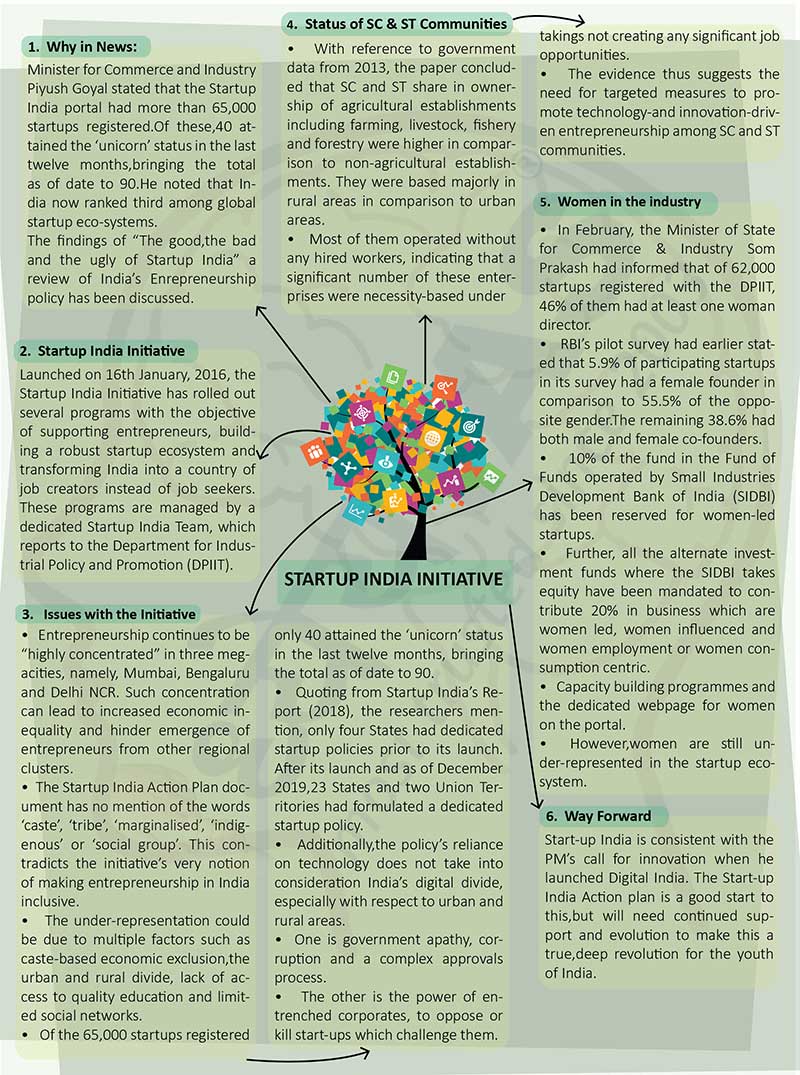Brain-booster
/
26 Apr 2022
Brain Booster for UPSC & State PCS Examination (Topic: Startup India Initiative)

Why in News?
- Minister for Commerce and Industry Piyush Goyal stated that the Startup
India portal had more than 65,000 startups registered.Of these,40 attained
the ‘unicorn’ status in the last twelve months,bringing the total as of date
to 90.He noted that India now ranked third among global startup eco-systems.
- The findings of “The good,the bad and the ugly of Startup India” a
review of India’s Enrepreneurship policy has been discussed.
Startup India Initiative
- Launched on 16th January, 2016, the Startup India Initiative has rolled
out several programs with the objective of supporting entrepreneurs,
building a robust startup ecosystem and transforming India into a country of
job creators instead of job seekers. These programs are managed by a
dedicated Startup India Team, which reports to the Department for Industrial
Policy and Promotion (DPIIT).
Issues with the Initiative
- Entrepreneurship continues to be “highly concentrated” in three
megacities, namely, Mumbai, Bengaluru and Delhi NCR. Such concentration can
lead to increased economic inequality and hinder emergence of entrepreneurs
from other regional clusters.
- The Startup India Action Plan document has no mention of the words
‘caste’, ‘tribe’, ‘marginalised’, ‘indigenous’ or ‘social group’. This
contradicts the initiative’s very notion of making entrepreneurship in India
inclusive.
- The under-representation could be due to multiple factors such as
caste-based economic exclusion,the urban and rural divide, lack of access to
quality education and limited social networks.
- Of the 65,000 startups registered only 40 attained the ‘unicorn’ status
in the last twelve months, bringing the total as of date to 90.
- Quoting from Startup India’s Report (2018), the researchers mention,
only four States had dedicated startup policies prior to its launch. After
its launch and as of December 2019,23 States and two Union Territories had
formulated a dedicated startup policy.
- Additionally,the policy’s reliance on technology does not take into
consideration India’s digital divide, especially with respect to urban and
rural areas.
- One is government apathy, corruption and a complex approvals process.
- The other is the power of entrenched corporates, to oppose or kill
start-ups which challenge them.
Status of SC & ST Communities
- With reference to government data from 2013, the paper concluded that SC
and ST share in ownership of agricultural establishments including farming,
livestock, fishery and forestry were higher in comparison to
non-agricultural establishments. They were based majorly in rural areas in
comparison to urban areas.
- Most of them operated without any hired workers, indicating that a
significant number of these enterprises were necessity-based under takings
not creating any significant job opportunities.
- The evidence thus suggests the need for targeted measures to promote
technology-and innovation-driven entrepreneurship among SC and ST
communities.
Women in the industry
- In February, the Minister of State for Commerce & Industry Som Prakash
had informed that of 62,000 startups registered with the DPIIT, 46% of them
had at least one woman director.
- RBI’s pilot survey had earlier stated that 5.9% of participating
startups in its survey had a female founder in comparison to 55.5% of the
opposite gender.The remaining 38.6% had both male and female co-founders.
- 10% of the fund in the Fund of Funds operated by Small Industries
Development Bank of India (SIDBI) has been reserved for women-led startups.
- Further, all the alternate investment funds where the SIDBI takes equity
have been mandated to contribute 20% in business which are women led, women
influenced and women employment or women consumption centric.
- Capacity building programmes and the dedicated webpage for women on the
portal.
- However,women are still under-represented in the startup ecosystem.
Way Forward
- Start-up India is consistent with the PM’s call for innovation when he
launched Digital India. The Start-up India Action plan is a good start to
this,but will need continued support and evolution to make this a true,deep
revolution for the youth of India.







